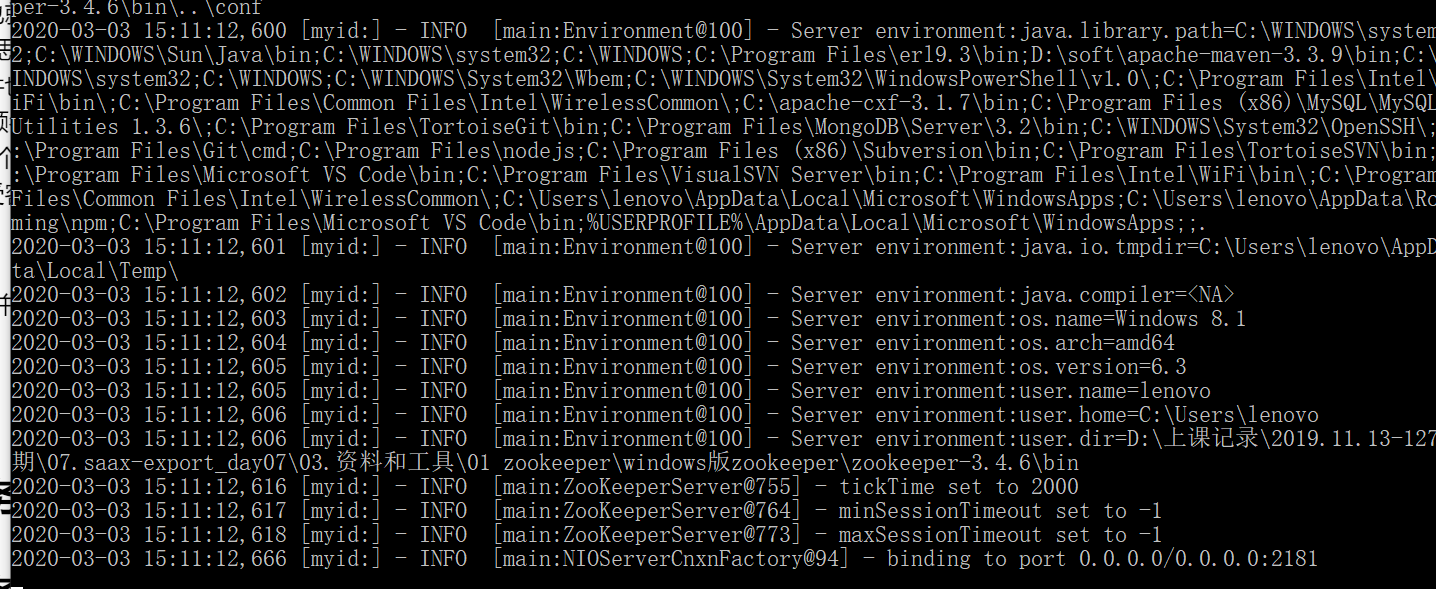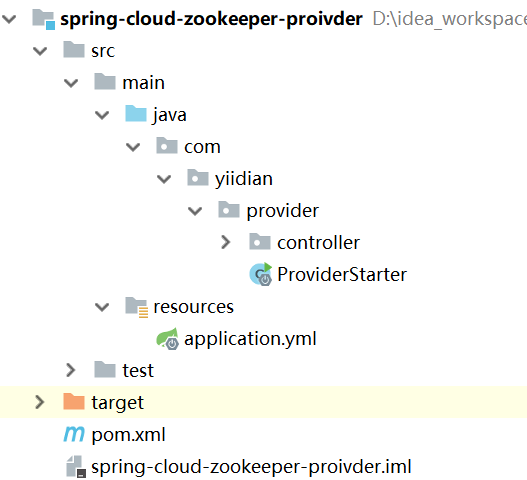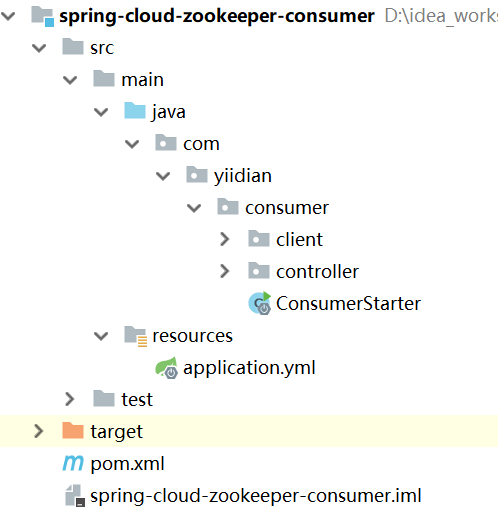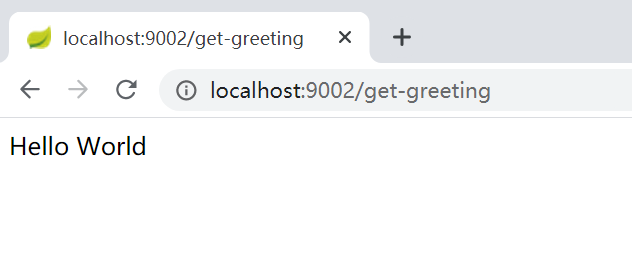1. 简介
本文将介绍如何使用Zookeeper在微服务框架中实现服务发现,该服务发现机制可作为云服务的注册中心。通过Spring Cloud Zookeeper为应用程序提供一种Spring Boot集成,将Zookeeper通过自动配置和绑定 的方式集成到Spring环境中。
在本例子中我们将创建两个应用程序:
- 提供服务的应用程序(称为
服务提供者) - 使用此服务的应用程序(称为
服务消费者)
2. 安装Zookeeper
2.1 下载
Apache官方最新版本为:3.4.8
下载地址:http://mirrors.cnnic.cn/apache/zookeeper/zookeeper-3.4.8/zookeeper-3.4.8.tar.gz
2.2 安装
解压到指定目录下 D:softzookeeper-3.4.8 修改zoo_sample.cfg 文件名(D:softzookeeper-3.4.8conf) 为 zoo.cfg主要修改一下日志位置,具体配置文件如下:
# The number of milliseconds of each tick
tickTime=2000
# The number of ticks that the initial
# synchronization phase can take
initLimit=10
# The number of ticks that can pass between
# sending a request and getting an acknowledgement
syncLimit=5
# the directory where the snapshot is stored.
# do not use /tmp for storage, /tmp here is just
# example sakes.
dataDir=D:\zookeeper\data
dataLogDir=D:\zookeeper\log
# the port at which the clients will connect
clientPort=2181
# the maximum number of client connections.
# increase this if you need to handle more clients
#maxClientCnxns=60
#
# Be sure to read the maintenance section of the
# administrator guide before turning on autopurge.
#
# http://zookeeper.apache.org/doc/current/zookeeperAdmin.html#sc_maintenance
#
# The number of snapshots to retain in dataDir
#autopurge.snapRetainCount=3
# Purge task interval in hours
# Set to "0" to disable auto purge feature
#autopurge.purgeInterval=1
tickTime:这个时间是作为 Zookeeper 服务器之间或客户端与服务器之间维持心跳的时间间隔,也就是每个 tickTime 时间就会发送一个心跳。dataDir:顾名思义就是 Zookeeper 保存数据的目录,默认情况下,Zookeeper 将写数据的日志文件也保存在这个目录里。dataLogDir:顾名思义就是 Zookeeper 保存日志文件的目录clientPort:这个端口就是客户端连接 Zookeeper 服务器的端口,Zookeeper 会监听这个端口,接受客户端的访问请求。
2.3 启动
进入到bin目录,并且启动zkServer.cmd,这个脚本中会启动一个java进程,双击该文件即可启动:

3. 搭建服务提供者
我们将创建一个服务提供者,通过增加pring-cloud-starter-zookeeper-discovery依赖和在主程序中引入@EnableDiscoveryClient注释。服务的具体内容是通过GET请求返回“Hello World!”字符串。
整个项目结构如下:

3.1 导入依赖
<?xml version="1.0" encoding="UTF-8"?>
<project xmlns="http://maven.apache.org/POM/4.0.0"
xmlns:xsi="http://www.w3.org/2001/XMLSchema-instance"
xsi:schemaLocation="http://maven.apache.org/POM/4.0.0 http://maven.apache.org/xsd/maven-4.0.0.xsd">
<modelVersion>4.0.0</modelVersion>
<groupId>com.yiidian</groupId>
<artifactId>spring-cloud-zookeeper-proivder</artifactId>
<version>1.0-SNAPSHOT</version>
<parent>
<groupId>org.springframework.boot</groupId>
<artifactId>spring-boot-starter-parent</artifactId>
<version>2.0.1.RELEASE</version>
<relativePath/> <!-- lookup parent from repository -->
</parent>
<properties>
<project.build.sourceEncoding>UTF-8</project.build.sourceEncoding>
<project.reporting.outputEncoding>UTF-8</project.reporting.outputEncoding>
<java.version>1.8</java.version>
</properties>
<dependencies>
<!-- SpringBoot 对Web支持 SpringMVC相关功能,json转换的功能等等 -->
<dependency>
<groupId>org.springframework.boot</groupId>
<artifactId>spring-boot-starter-web</artifactId>
</dependency>
<dependency>
<groupId>org.springframework.cloud</groupId>
<artifactId>spring-cloud-starter-zookeeper-discovery</artifactId>
</dependency>
</dependencies>
<!-- 定义SpringCloud版本 -->
<repositories>
<repository>
<id>spring-snapshots</id>
<name>Spring Snapshots</name>
<url>https://repo.spring.io/snapshot</url>
<snapshots>
<enabled>true</enabled>
</snapshots>
</repository>
<repository>
<id>spring-milestones</id>
<name>Spring Milestones</name>
<url>https://repo.spring.io/milestone</url>
<snapshots>
<enabled>false</enabled>
</snapshots>
</repository>
</repositories>
<dependencyManagement>
<dependencies>
<dependency>
<groupId>org.springframework.cloud</groupId>
<artifactId>spring-cloud-dependencies</artifactId>
<version>Finchley.M9</version>
<type>pom</type>
<scope>import</scope>
</dependency>
</dependencies>
</dependencyManagement>
</project>
3.2 启动类
使用@EnableDiscoveryClient注释我们的主类,这将使HelloWorld 应用程序自动发布。
package com.yiidian.provider;
import org.springframework.boot.SpringApplication;
import org.springframework.boot.autoconfigure.SpringBootApplication;
import org.springframework.cloud.client.discovery.EnableDiscoveryClient;
/**
* 服务提供者启动类
*/
@SpringBootApplication
@EnableDiscoveryClient
public class ProviderStarter {
public static void main(String[] args) {
SpringApplication.run(ProviderStarter.class,args);
}
}
3.3 Controller
package com.yiidian.provider.controller;
import org.springframework.stereotype.Controller;
import org.springframework.web.bind.annotation.GetMapping;
import org.springframework.web.bind.annotation.RestController;
/**
* 一点教程网: http://www.yiidian.com
* 控制器
*/
@RestController
public class HelloController {
@GetMapping("/hello")
public String hello(){
return "Hello World";
}
}
3.4 配置application.yml
在application.yml中定义服务名称用来被客户端调用,同时配置Zookeeper信息用来注册服务。
server:
port: 9001
spring:
application:
name: Provider
cloud:
zookeeper:
discovery:
enabled: true
connect-string: localhost:2181
logging:
level:
org.apache.zookeeper.ClientCnxn: WARN
4. 搭建服务消费者
现在我们来创建一个REST服务消费者,它使用spring Netflix Feign Client来调用服务。先看看整个项目结构:
4.1 导入依赖
在pom文件里增加需要依赖的一些组件包。
<?xml version="1.0" encoding="UTF-8"?>
<project xmlns="http://maven.apache.org/POM/4.0.0"
xmlns:xsi="http://www.w3.org/2001/XMLSchema-instance"
xsi:schemaLocation="http://maven.apache.org/POM/4.0.0 http://maven.apache.org/xsd/maven-4.0.0.xsd">
<modelVersion>4.0.0</modelVersion>
<groupId>com.yiidian</groupId>
<artifactId>spring-cloud-zookeeper-consumer</artifactId>
<version>1.0-SNAPSHOT</version>
<parent>
<groupId>org.springframework.boot</groupId>
<artifactId>spring-boot-starter-parent</artifactId>
<version>2.0.1.RELEASE</version>
<relativePath/> <!-- lookup parent from repository -->
</parent>
<properties>
<project.build.sourceEncoding>UTF-8</project.build.sourceEncoding>
<project.reporting.outputEncoding>UTF-8</project.reporting.outputEncoding>
<java.version>1.8</java.version>
</properties>
<dependencies>
<!-- SpringBoot 对Web支持 SpringMVC相关功能,json转换的功能等等 -->
<dependency>
<groupId>org.springframework.boot</groupId>
<artifactId>spring-boot-starter-web</artifactId>
</dependency>
<dependency>
<groupId>org.springframework.cloud</groupId>
<artifactId>spring-cloud-starter-zookeeper-discovery</artifactId>
</dependency>
<dependency>
<groupId>org.springframework.cloud</groupId>
<artifactId>spring-cloud-starter-openfeign</artifactId>
</dependency>
</dependencies>
<!-- 定义SpringCloud版本 -->
<repositories>
<repository>
<id>spring-snapshots</id>
<name>Spring Snapshots</name>
<url>https://repo.spring.io/snapshot</url>
<snapshots>
<enabled>true</enabled>
</snapshots>
</repository>
<repository>
<id>spring-milestones</id>
<name>Spring Milestones</name>
<url>https://repo.spring.io/milestone</url>
<snapshots>
<enabled>false</enabled>
</snapshots>
</repository>
</repositories>
<dependencyManagement>
<dependencies>
<dependency>
<groupId>org.springframework.cloud</groupId>
<artifactId>spring-cloud-dependencies</artifactId>
<version>Finchley.M9</version>
<type>pom</type>
<scope>import</scope>
</dependency>
</dependencies>
</dependencyManagement>
</project>
4.2 启动类
同服务提供者一样在主程序中增加@EnableDiscoveryClient 注解。
package com.yiidian.consumer;
import org.springframework.boot.SpringApplication;
import org.springframework.boot.autoconfigure.SpringBootApplication;
import org.springframework.cloud.client.discovery.EnableDiscoveryClient;
import org.springframework.cloud.openfeign.EnableFeignClients;
/**
*服务消费者启动类
*/
@SpringBootApplication
@EnableDiscoveryClient
@EnableFeignClients
public class ConsumerStarter {
public static void main(String[] args) {
SpringApplication.run(ConsumerStarter.class,args);
}
}
4.3 定义Feign远程接口
通过引入spring-cloud-starter-openfeign组件包使用声明式服务调用方式调用远程服务,使用@FeignClient(“service-name”)注解一个接口并将它自动连接到我们的应用程序中,以便我们以编程方式访问此服务。
package com.yiidian.consumer.client;
import org.springframework.cloud.openfeign.FeignClient;
import org.springframework.web.bind.annotation.GetMapping;
/**
* Feign远程接口
*/
@FeignClient("Provider")
public interface HelloClient {
@GetMapping("/hello")
public String hello();
}
4.4 Controller
以下是一个简单的服务控制器类,它通过注入接口helloWorldClient对象调用服务提供者的接口来消费该服务,并在响应中显示它的返回值。
package com.yiidian.consumer.controller;
import com.yiidian.consumer.client.HelloClient;
import org.springframework.beans.factory.annotation.Autowired;
import org.springframework.web.bind.annotation.GetMapping;
import org.springframework.web.bind.annotation.RestController;
/**
* 消费者控制器
*/
@RestController
public class GreetingController {
@Autowired
private HelloClient helloClient;
@GetMapping("/get-greeting")
public String greeting() {
return helloClient.hello();
}
}
4.5 配置application.yml
server:
port: 9002
spring:
application:
name: Consumer
cloud:
zookeeper:
discovery:
enabled: true
connect-string: localhost:2181
logging:
level:
org.apache.zookeeper.ClientCnxn: WARN
5. 测试
HelloWorld REST服务在Zookeeper中注册了自己,Greeting服务通过声明式客户端发现和调用HelloWorld 服务。
现在我们可以运行这两个服务,然后在浏览器中访问 http://localhost:9002/get-greeting,将返回以下信息:

6. 总结
在本文中我们看到了如何使用Spring Cloud Zookeeper实现服务发现,并且在Zookeeper中注册了一个名为Hello World的服务。然后通过声明式服务调用方式实现了一个服务消费者Greeting来发现和使用该服务。
顺便介绍下Zookeeper与Eureka这两种服务治理框架的区别。Spring Cloud Eureka实现的服务治理机制强调了CAP原理中的AP,即可用性与可靠性,而Zookeeper强调CP(一致性、可靠性)。Eureka为了实现更高的服务可用性,牺牲了一定的一致性,在极端情况下它宁愿接受故障实例也不要丢掉“健康”实例,比如,当服务注册中心的网络发生故障断开时,由于所有的服务实例无法维持续约心跳,在强调CP的服务治理中将会把所有服务实例都剔除掉,而Eureka则会触发保护机制,保留此时的所有节点,以实现服务间依然可以进行互相调用的场景。